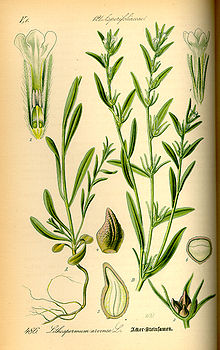Arable stone seeds
| Arable stone seeds | ||||||||||||
|---|---|---|---|---|---|---|---|---|---|---|---|---|

Arable rock seeds ( Buglossoides arvensis ) |
||||||||||||
| Systematics | ||||||||||||
|
||||||||||||
| Scientific name | ||||||||||||
| Buglossoides arvensis | ||||||||||||
| ( L. ) IMJohnst. |
The arable stone seed ( Buglossoides arvensis , syn .: Lithospermum arvense ), also known as " arable cattle tongue ", is a plant from the genus cow tongue ( Buglossoides ) from the predatory leaf family (Boraginaceae). It used to be assigned to the genus stone seeds ( Lithospermum ).
description
The arable rock seed is an annual , herbaceous plant that usually reaches heights of between 10 and 50 cm. The stem grows upright and is rarely branched at the bottom. He is pressed-bristly hairy. The stem has a reddish color at the base, this is also the reason for the older German term peasant make-up. The leaves are elongated egg-shaped to lanceolate in shape and closely covered with hairy bristles; the lower ones are narrowed into a stalk. They are usually pointed, rarely rounded. The flowers grow in the last elongated coils . The 6 to 8 mm wide crown is hardly longer than the calyx. It is usually white in color, very rarely also blue, reddish or creamy white. The yellowish-brown, triangular partial fruits are warty or pitted and have a length of 2 to 3.5 mm.
The flowering period extends essentially from April to July.
The number of chromosomes is 2n = 14 or 28.
Subspecies
The arable stone seed occurs in two subspecies:
- Buglossoides arvensis subsp. arvensis
- Bluish arable rock seed ( Buglossoides arvensis subsp. Sibthorpiana (Griseb.) R. Fern .; Syn .: Buglossoides arvensis var. Coerulescens (DC.) A. Hansen & Sunding ): It differs, among other things, by a mostly blue crown. It occurs in dry grassland and dry pine stands. Its chromosome number is 2n = 28.
ecology
The arable stone seed is an annual, summer and winter annual plant. It has roots up to 60 centimeters deep.
The flowers are female and produce only sparse nectar . They are therefore only rarely visited by butterflies , especially by whiteflies of the genus Pieris , and also by relatives of bees and hover flies . Spontaneous self-pollination is also possible.
The fruits are brown and dull Klausen . They have a wreath of hair in the wire-haired, breaking calyx and spread through Velcro. In addition, people spread through displacement with soil.
Locations and distribution
The species grows in cereal weed communities, along roadsides and occasionally on rubble. It prefers fresh to moderately fresh, nutrient-rich and base-rich, mild to moderately acidic, low-humus clay or loam soils. She is a species of the Secalietea class.
The arable rock seed occurs from the Mediterranean area north to Scandinavia, in North Africa, on the Canary Islands, as well as in West Asia, in the Caucasus, in Central Asia, India, Nepal, Pakistan, China, Japan and Siberia. As a neophyte, it also occurs in North America.
In Germany the species is quite common in the central and southern parts. It is less common in the west and north. The subspecies Buglossoides arvensis subsp. sibthorpiana can only be found on Hiddensee, Rügen and in a few places in Thuringia, Anhalt and East Brandenburg. In Austria, the arable rock seed occurs frequently in the Pannonian region , otherwise scattered or rarely. In Switzerland it is to be found generally absent-minded.
literature
- Henning Haeupler , Thomas Muer: picture atlas of the fern and flowering plants of Germany (= the fern and flowering plants of Germany. Volume 2). Published by the Federal Agency for Nature Conservation. Ulmer, Stuttgart 2000, ISBN 3-8001-3364-4 .
- Wolfgang Adler, Karl Oswald, Raimund Fischer: Excursion flora of Austria. Ed .: Manfred A. Fischer . Ulmer, Stuttgart / Vienna 1994, ISBN 3-8001-3461-6 .
- August Binz , Christian Heitz: School and excursion flora for Switzerland , Schwabe & Co. AG, Basel 1986, ISBN 3-7965-0832-4
- Erich Oberdorfer : Plant-sociological excursion flora , Ulmer Verlag, Stuttgart 1990, ISBN 3-8001-3454-3
- Christian August Friedrich Garcke : Illustrierte Flora , Verlag Paul Parey, 1972, ISBN 3-489-68034-0
- Ruprecht Düll , Herfried Kutzelnigg : Pocket dictionary of plants in Germany and neighboring countries. The most common Central European species in portrait. 7th, corrected and enlarged edition. Quelle & Meyer, Wiebelsheim 2011, ISBN 978-3-494-01424-1 .
Individual evidence
- ^ Sauerhoff, Friedhelm: Plant names in comparison: Studies on naming and etymology , Franz Steiner Verlag, Stuttgart 2001, ISBN 3-515-07857-6
- ↑ a b c d Erich Oberdorfer : Plant-sociological excursion flora for Germany and neighboring areas . With the collaboration of Angelika Schwabe and Theo Müller. 8th, heavily revised and expanded edition. Eugen Ulmer, Stuttgart (Hohenheim) 2001, ISBN 3-8001-3131-5 , pp. 779 .
- ^ Buglossoides in the Germplasm Resources Information Network (GRIN), USDA , ARS , National Genetic Resources Program. National Germplasm Resources Laboratory, Beltsville, Maryland. Retrieved July 19, 2020.
Web links
- Arable stone seeds. In: FloraWeb.de.
- Arable stone seeds . In: BiolFlor, the database of biological-ecological characteristics of the flora of Germany.
- Buglossoides arvensis (L.) IM Johnst. In: Info Flora , the national data and information center for Swiss flora . Retrieved February 5, 2016.
- Distribution in the northern hemisphere according to Eric Hultén
- Thomas Meyer: Stone data sheet with identification key and photos at Flora-de: Flora von Deutschland (old name of the website: Flowers in Swabia )


